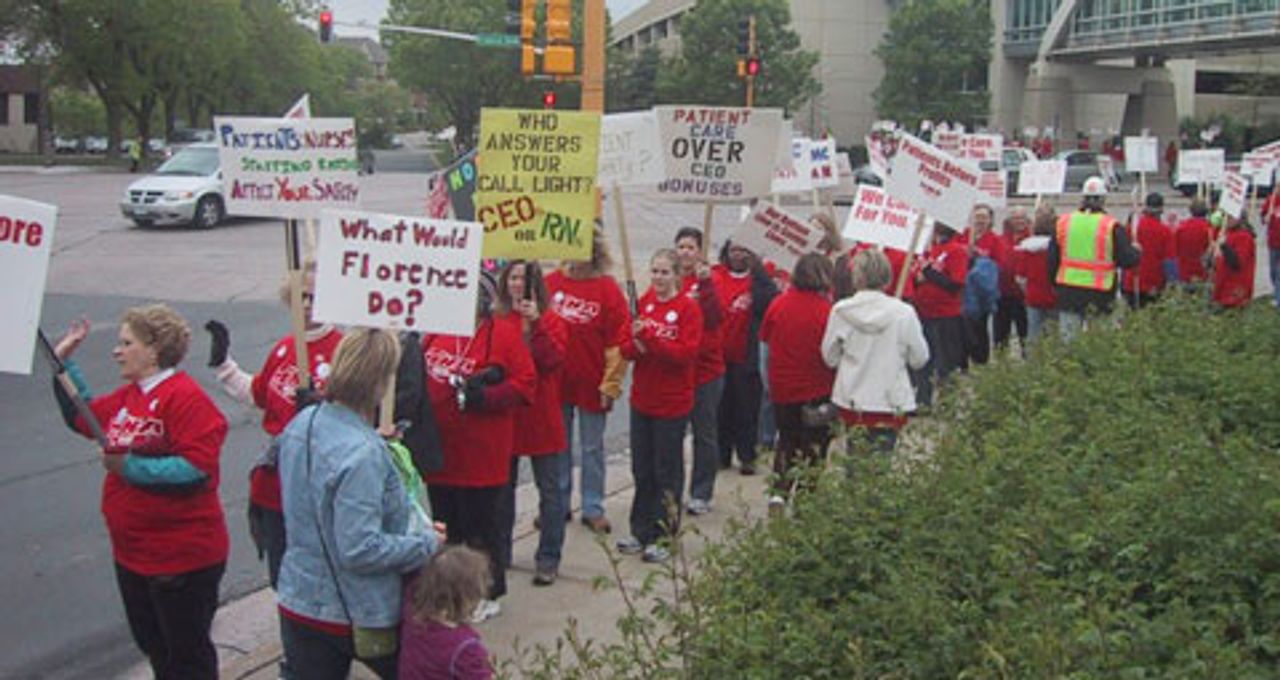 Nurses rally at Children's Hospital in St. Paul, Minnesota
Nurses rally at Children's Hospital in St. Paul, MinnesotaMore than 12,000 Twin Cities-area nurses will vote on Wednesday on a takeaway contract demanded by six Minnesota hospital systems. If the contract is rejected and no new agreement is reached by the June 1 deadline, a walkout would be the largest nurses’ strike in US history. Some 2,500 nurses rallied at locations in St. Paul and a suburb of Minneapolis last week to press their demands.
“This is the eighth week of negotiations and not a single employer has been willing to discuss any of our proposals,” Joni Ketter, director of organizing for the Minnesota Nurses Association (MNA) told the World Socialist Web Site. “We’re negotiating with six different hospitals at six different tables, and we’re confronted with the same basic set of concessions at every table. The hospitals admit that they are coordinating their bargaining. They have lawyers at four of the six tables that are from the same firm. Unless we see a major movement by these hospitals, I think they will be forcing these nurses to make a decision about whether or not to strike.”
Among the issues nurses are pressing for is increased staffing levels, which nurses insist directly affects patient safety. Nurses are also seeking to get contract language that would require the hospitals to implement planning and provide proper equipment in the event of a disaster where it is widely acknowledged that nurses would be on the front lines in the event of an H1N1/swine flu or similar outbreak. In addition, nurses are asking for contract language that makes sure technology enhances patient care instead of endangering it.
 A section of nurses picketing at Fairview
A section of nurses picketing at FairviewSouthdale Hospital in Edina, Minnesota
Meanwhile, hospital management is intent on gutting the nurses’ defined benefit pension fund. The MNA charges the hospitals’ proposal will reduce benefits by one-third and set them back to 1968 levels. The hospitals also want to hike the number of days that they can do last-minute shift cancellations from 3 to 15—the equivalent of a two-week paycheck that could force nurses to use vacation pay to fill the gap.
The MNA has asked for 4.5 percent wage increases in each of the next three years. Management is seeking to freeze wages in the first year, followed by increases of 1 percent in the second year and 2 percent in year three.
Jill, a nurse in the Allina Hospital & Clinics system, explained the importance of patient care issues to the WSWS. “First of all, I believe all the contract issues that we are bargaining for are important. But probably one of the biggest concerns for nurses and therefore most important is maintaining the safety of patients.
“Under ‘flexibility’, what the hospital is trying to obtain is the option that when one unit is overstaffed with nurses and another unit is understaffed, they want to pull those nurses and ‘float’ them to those understaffed units, rather then making nurses take time off. In some cases it is appropriate. The language wording the hospitals put in the contract says that they want to use the right nurse, in the right place, at the right time. They want to take what they call a ‘qualified’ nurse to care for ‘like’ patients.
“The problem with that is, who determines what is a ‘like’ patient and who is a ‘qualified’ nurse. The hospital wants to have sole discretion on this. But the nurses may have a different opinion on who is a ‘like’ patient or who is ‘qualified’ to care for those patients.
“I work in OB (obstetrics). I would not feel comfortable in a med-surg unit. Or if they tell me that because I'm used to working with female anatomy or female reproductive systems, therefore, they might expect me to care for a post-surgical patient who has had a hysterectomy. I would not feel qualified in either of these cases. We all have our clinical specialties.
“The hospitals’ refusal to address nurse-to-patient ratios, along with unsafe floating proposals puts my license at risk. I want to protect my licensure. Nurses do not want to be put in a compromising position where we could be held liable. When things go wrong there can be reprimands and unsafe practice issues. And those issues follow a nurse wherever they go in their career.
“So it is up to us to speak up when we get put in these compromising positions and say we need guarantees to maintain safe care.”
Nurses taking part in May 12th picketing emphasized that their profession requires widely differing skills within the various complex fields that make up medicine today.
And there is new research to back the nurses’ demand for increased staffing levels. A study by Health Services Research (HSR) released earlier this year looked at nurse ratios between 2004-2006. It compared research results between California hospitals in the wake of legislation that for the first time mandated minimum nurse-to-patient staffing ratios, and hospitals in New Jersey and Pennsylvania where such regulation does not exist.
Among some of the study’s findings is that California nurses “care for an average of one fewer patient each, and these lower ratios have sizable effects on surgical patient mortality. In medical and surgical units, where nurse recruitment and retention has long been difficult nationally, nurses in California on average care for over two fewer patients than nurses in New Jersey and 1.7 fewer patients than nurses in Pennsylvania.”
 Nurses rally in front of Fairview Southdale Hospital in Edina, Minnesota
Nurses rally in front of Fairview Southdale Hospital in Edina, MinnesotaThe study states that if the California mandates were applied to New Jersey, there would be 13.9 percent fewer surgical deaths. If applied to Pennsylvania, there would be 10.6 percent fewer surgical deaths. The study also found that nurses in the states without mandated staffing ratios had “significantly higher odds…of reporting complaints from patients or families and verbal abuse by patients or staff…. They also have significantly higher odds on reporting high burnout, job dissatisfaction, and poor or fair work environments and quality of care….”
Another factor in hospital managements’ calculations is the belief that the California legislation—which lowered the nurse-patient ratio—led to increased demand for registered nurses and higher wages.
The Minneapolis Star-Tribune drew attention to a survey by St. Catherine University, located in St. Paul. Among the respondents that are graduating from the school’s nursing program, only 34 percent indicated that they had found jobs. It would seem rational that unemployed nurses should be hired at hospitals across the nation to implement lower nurse-to-patient ratios in the interest of patient.
But the health care industry is focused on profits. Despite the “nonprofit” moniker, these institutions provide a framework for countless corporations to amass fortunes. Among the six hospital systems involved in the contract struggle, Allina Health System leads the way with 2008 revenues that amounted to $2.7 billion while its recently retired CEO emeritus Richard Pettingill pulled down a $1.74 million salary. CEOs at the other five hospitals ranked as follows: Alan Goldbloom, Children’s Hospital’s and Clinics, received $1.25 million; Timothy Hanson at Health East garnered $1.12 million; Mark Eustis at Fairview Health Services got $1.01 million; David Wessner, recently retired from Park Nicollet Health Services made $995,000; and David Cress at North Memorial rounds out the group with a salary of $957,300.
As the recession deepens, the health care industry is intent on reducing the living standards of nurses and other hospital workers to assure their profitability. At the same time, the federal and state governments under direction of the insurance companies are more and more implementing changes that will make health care conform to a class-based system where workers will find their access to medical assistance severely undermined or placed out of reach.
The Minnesota Nurses Association is incapable and opposed to any struggle against profit-based health care. The MNA was an avid supporter of Obama’s health care overhaul plan, which was chiefly drawn up by the insurance companies and other corporate interests. With its focus on cost-cutting “efficiencies,” the plan will inevitably be used to attack the jobs and working conditions of all health care workers.
The struggle of the Minnesota nurses therefore must become part of an overall struggle of the entire working class independent of both the Democratic and Republican parties of big business to defend its living standards and health care. This means that the giant hospital systems must be nationalized and placed under the control of a workers’ government.
